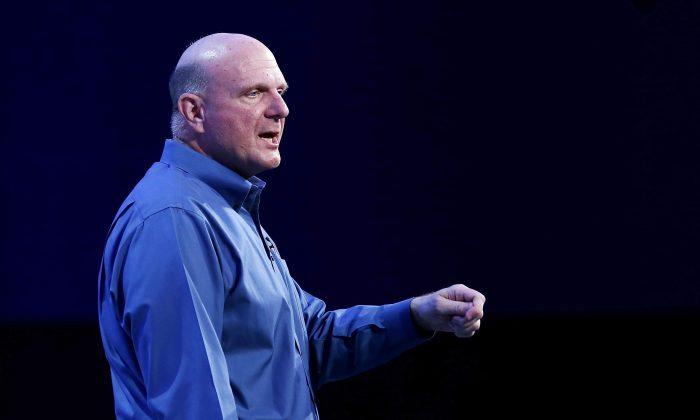Microsoft Corp. has been criticized for being late to the game on many fronts.
As Microsoft tries to remain a relevant player in markets they historically have ignored, questions abound as to how the company planned to overcome its competitors. Executives answered, in their first financial analysts meeting in two years, with much optimism but without much detail.
“Google happens to say let’s not have any profit be in the device. Let’s move it all into search. We and Apple kind of have a different view of the world,” Microsoft CEO Steve Ballmer said at the Sept. 19 meeting. “Amazon, I don’t know where they want to put market profit, they don’t seem to put the profit anywhere. And that’s not a shot, it’s just I can’t tell you what profit stream is important to them the way we can about us or Apple or Google.”
Fighting in the Cloud
Enterprise software makes up 55 percent of Microsoft’s business, and fiscal year 2014 will continue to reflect its transition to focusing on cloud storage.
Article Continues after the discussion. Vote and comment
[tok id=3d91d16938b3ff1c04134537a36835f partner=1966]The cloud computing market is evolving, according to analyst Jeffrey Hammond at Forrester Research, but there is currently no clear leader.
Microsoft Chief Operating Officer Kevin Turner said Microsoft Azure is superior to Amazon Web Service as platform-as-a-service (PaaS).
Article Continues after the discussion. Vote and comment
[tok id=3d91d16938b3ff1c04134537a36835f partner=1966]
The majority of developers will choose Amazon for cloud computing, as it offers five times more utilized capacity than 14 of its competitors combined, Forrester’s report found. Microsoft Azure, which grew 200 percent in a year, is second at 39 percent market share and Google Cloud Platform has 29 percent. Turner added that Microsoft was winning back enterprise customers from Google one at a time.
Amazon leads as the choice for developers for storage and relational database management systems, but Microsoft said Azure has an “unparalleled adoption rate” at nearly 1,000 customers daily.
“There’s no question that the time for cloud computing is now, and it’s critical we help enterprises embrace the cloud on their terms,” stated Satya Nadella, Microsoft’s executive vice president of cloud and enterprise.
Microsoft recently announced a partnership with AT&T allowing its customers private cloud access through Microsoft’s public cloud by 2014. AT&T serves 3.5 million business customers and Microsoft hopes to get Azure in front of these potential customers.
However, Amazon has plans to grow significantly not just in the public cloud, but also in the enterprise cloud space. Earlier this year Amazon hired over 200 salespeople for its cloud service, and earlier this month placed ads for developer positions along the shuttle commute to Microsoft’s campus (both companies are located in the state of Washington). Amazon has also reduced its cloud services prices 27 times since its 2006 launch—which Azure has tried to match.
Morgan Stanley projected Amazon’s cloud services revenue to hit $24 billion by 2022. If Amazon wins the bid for providing the CIA server space after IBM’s challenge, that would elevate Amazon’s credibility to other companies as well.
But Microsoft hopes to create a smooth and quick transition for its enterprise clients from licensed to cloud-subscription software.
“The new Microsoft says we’re getting a much richer and deeper share of wallet from those customers who go to the cloud with us. And we see this over and over again,” Turner said.
Public cloud is estimated to be a $185 billion market by 2014 according to research firm Gartner.
“We’re continuing to work through how to bring and be the strongest productivity player across all platforms including iOS and Android in the marketplace,” Turner said. “We want to be the leader in mobile device management.”
Apple Inc. doesn’t allow applications to be sold in suites in the iTunes store, so users would have to download Office 365 applications separately, but Apple recently released the productivity suite iWork for free to its iOS7 users. Google made its Quickoffice application free on Sept. 19.
Google, Apple
Smartphone ownership is up 15 percent in the United States over the past three months. According to research firm Nielsen, 53 percent of all U.S. smartphones phones run on Android, 40 percent on iOS, and 2 percent on Windows. As of Sept. 17, BlackBerry had just taken back third place as a smartphone operating system ahead of Windows.
Microsoft has been fairly vocal about Google’s “monopoly” on search but Ballmer was optimistic Bing would prove to be a contender.
According to comScore, Google leads the Web search market with 67 percent share, and Bing is a distant second with 17.9 percent. Ballmer said Microsoft will try to make up for scale by turning to devices. Google search isn’t actually required as a default on Android devices, and devices like Kindle Fire and Samsung Galaxy S started with Bing as their default search engine. Bing is now the search of choice on Apple’s Siri as well.
Advertising revenue on Bing grew 32 percent, and the number of users grew 13 percent over the past year.
Microsoft is still first and foremost in the enterprise software business, said Chief Financial Officer Amy Hood, but its consumer and device businesses will support that.
The new businesses will require consistently higher capital expenditures than Microsoft’s investors are used to seeing, and Hood stressed that this was a sign of success. Microsoft’s capital expenditures will increase to $6.5 billion in 2014.
“Hardware is leading where we’re going to go in innovation,” said Julie Larson-Green, executive vice president of devices and studios. This is new for the company that has long had a software-first approach. The hardware Microsoft has embraced in the past has always been to further a software experience, Larson-Green said.
Microsoft’s recent move to buy Nokia Corp.’s phone businesses has been compared to Google’s purchase of Motorola Mobility in 2011 in an effort to mimic the way Apple does business (putting hardware and software development under one roof). In a recent interview with Bloomberg Businessweek, Apple CEO Tim Cook said this only shows that other companies have finally recognized the importance of integrating software and hardware.
Microsoft will host a call to answer questions on Sept. 26 before its financial earnings release in October.






Friends Read Free